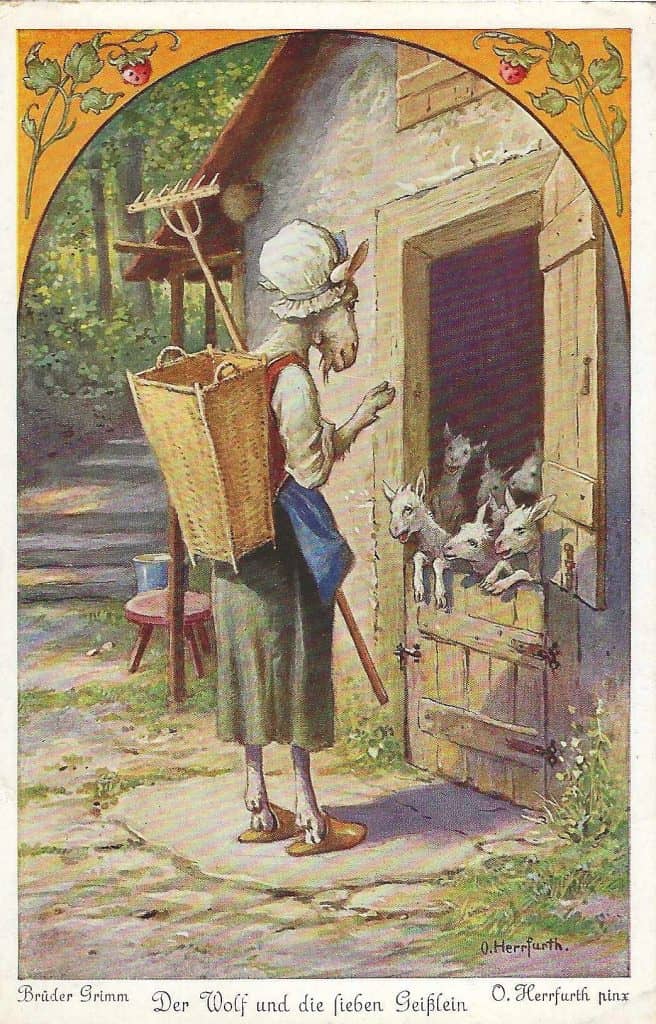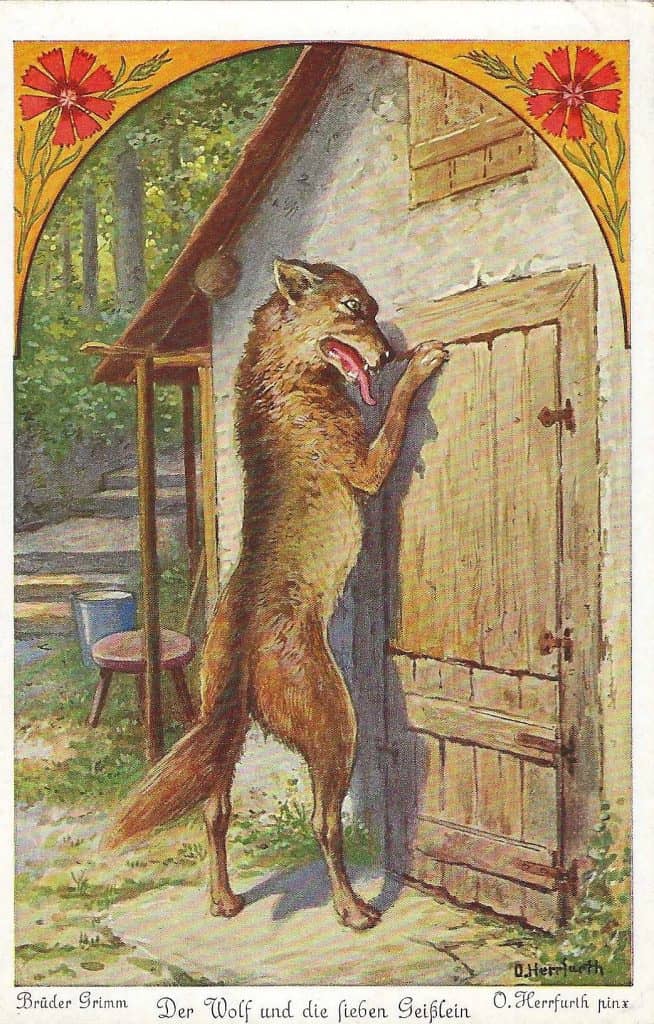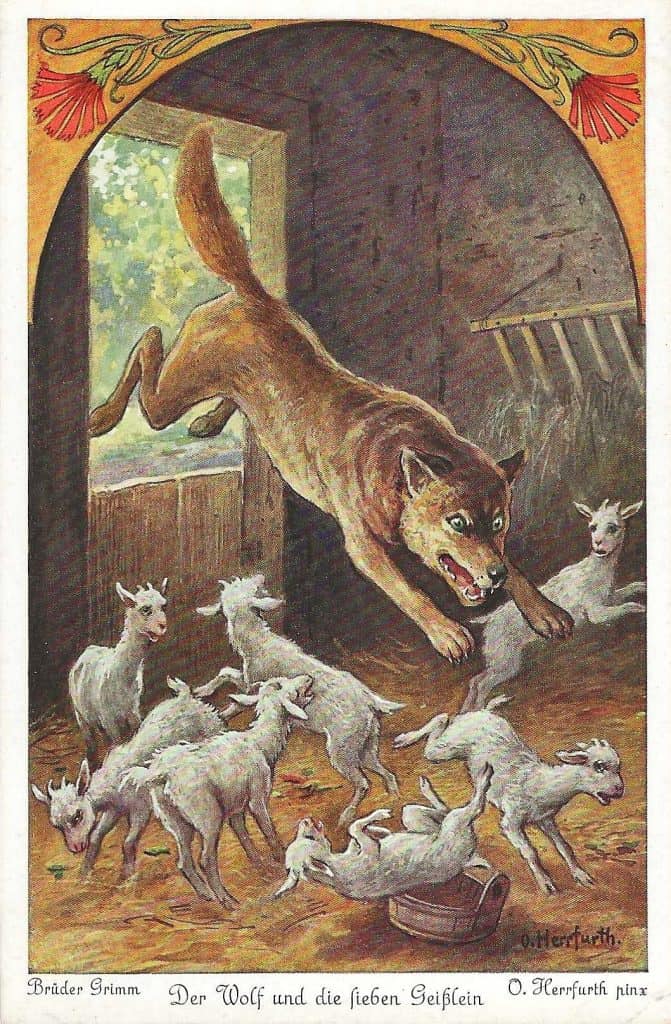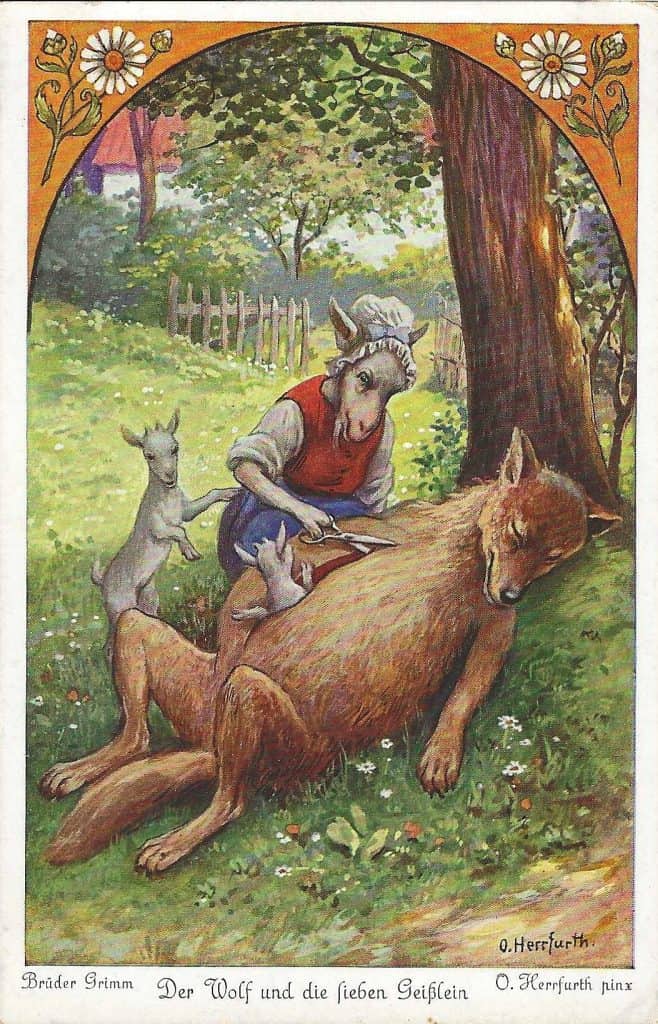In June 2022, Postcard History contributor Eleanor “Ellie” McCracken introduced you to a set of Bruder Grimm (The Brothers Grimm, Jacob and Wilhem) postcards entitled “The Town Musicians of Bremen,” published by the Uvachrome Company in Germany.
Good fortune has smiled on Postcard History and a second set of Grimm cards has been located by the same artist. Oskar Herrfurth was born in 1862 and enjoyed a privileged childhood in the medieval village of Merseburg (about 18 miles west of Leipzig). At a time when students received an education determined by family and religion and based on demonstrated talents, he was enrolled in the art school in Weimar. After completion of his studies, he remained in Weimar and found work as a book illustrator and servant to the art community. His skills in creation of image from concept was highly lauded in the German press. His genre paintings, illustrations, and fairy tale pictures provided an abundant income for more than two decades.
The new set of cards is titled, “The Wolf and the Seven Kids.” The story was published by the Brothers Grimm in the first edition of their Kinder und Hausmärchen (Children’s and Household Tales) in 1812.
***
Jacob and Wilhelm Grimm
present
The Wolf and the Seven Kids
Once upon a time there was a mother goat. She had seven little kids, and loved them all, just as a mother loves her children. One day she wanted to go into the woods to get some food. So she called all seven to her and said, “Children dear, I am going into the woods. Be on your guard for the wolf. If he gets in, he will eat up all of you, even your skin and hair. The villain often disguises himself, but you will recognize him at once by his rough voice and his black feet.”
The kids said, “Mother dear, we will take care of ourselves. You can go away without any worries.”

Then the old one bleated and went on her way with her mind at ease.

It was not long before someone knocked at the door and called out, “Open the door, children dear, your mother is here, and has brought something for each one of you.”
But the little kids knew from the rough voice that it was the wolf.
“We will not open the door,” they cried out. “You are not our mother. She has a soft and gentle voice, but your voice is rough. You are the wolf.”
So the wolf went to a shopkeeper and bought himself a large piece of chalk, which he ate, making his voice soft. Then he came back and knocked at the door, calling out, “Open the door, children dear. Your mother is here and has brought something for each one of you.”
But the wolf laid one of his black paws inside the window. The children saw it and cried out, “We will not open the door. Our mother does not have a black foot like you. You are the wolf.”
So the wolf ran to a baker and said, “I have sprained my foot. Rub some dough on it for me.” After the baker had rubbed dough on his foot, the wolf ran to the miller and said, “Sprinkle some white flour on my foot for me.”
The miller thought that the wolf wants to deceive someone, and refused to do it, so the wolf said, “If you will not do it, I will eat you up.” That frightened the miller, and he made his paw white for him. Yes, that is the way people are.
Now the villain went for a third time to the door, knocked at it, and said, “Open the door for me, children. Your dear little mother has come home and has brought every one of you something from the woods.”
The little kids cried out, “First show us your paw so we may know that you are our dear little mother.”
The wolf put his paw inside the window, and when they saw that it was white, they believed that everything he said was true, and they opened the door. But who came in? It was the wolf.

They were terrified and wanted to hide. One jumped under the table, the second into the bed, the third into the stove, the fourth into the kitchen, the fifth into the cupboard, the sixth under the washbasin, and the seventh into the clock case. But the wolf found them all, and with no further ado he swallowed them down his throat, one after the other. However, he did not find the youngest kid, the one who was in the clock case.
After satisfying his appetite he went outside and lay down under a tree in the green meadow and fell asleep.
Soon afterward the mother goat came home from the woods. Oh, what a sight she saw. The door stood wide open. Table, chairs, and benches were tipped over. The washbasin was in pieces. The covers and pillows had been pulled off the bed. She looked for her children, but they were nowhere to be found. She called them by name, one after the other, but no one answered. When she at last came to the youngest, a soft voice cried out, “Mother dear, I am hiding in the clock case. She took it out, and it told her that the wolf had come and had eaten up all the others. You can just imagine how she cried for her poor children.
Finally in her despair she went outside, and the youngest kid ran with her. They came to the meadow, and there lay the wolf by the tree, snoring so loudly that the branches shook. She looked at him from all sides and saw that something was moving and jiggling inside his full belly.

“Good gracious,” she said. “Is it possible that my poor children, whom he has swallowed down for his supper, can still be alive?”
The mother goat sent the kid home to fetch scissors and a needle and thread, and then she cut open the monster’s paunch. She had scarcely made one cut, before a little kid stuck its head out, and as she continued to cut, one after the other all six jumped out, and they were all still alive. They were not even hurt, for in his greed the monster had swallowed them down whole. How happy they were! They hugged their dear mother and jumped about like a tailor on his wedding day.
But the mother said, “Go now and look for some big stones. We will fill the godless beast’s stomach with them while he is still asleep.”
The seven kids quickly brought the stones, and they put as many of them into his stomach as it would hold. Then the mother hurriedly sewed him up again. He was not aware of anything and never once stirred.
The wolf finally awoke and got up on his legs. Because the stones in his stomach made him very thirsty, he wanted to go to a well and get a drink. But when he began to walk and to move about, the stones in his stomach knocked against each other and rattled. Then he cried out: ”What rumbles and tumbles, Inside of me. I thought it was kids, But it’s stones that they be.”
When he got to the well and leaned over the water to drink, the heavy stones pulled him down, and he drowned miserably.

When the seven kids saw what had happened, they ran up and cried out, “The wolf is dead! The wolf is dead!” And with their mother they danced for joy around and about the well.
Interesting set of cards!
Oh, this brings back memories! I had a book as a child with this story (a Ladybird book, if I’m not mistaken) and reading this brought back memories of the pages and the illustrations in it.. interesting that it is the subject of a postcard set!
Thanks for telling the entire tale. I especially like the detail of the mother goat holding the scissors in her hoof to cut open the wolf.
interesting and delightful cards. So well drawn. Thanks